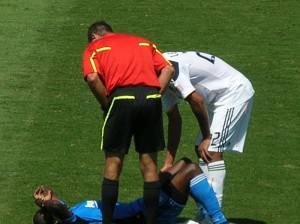Even people who can’t understand the fascination of sports have probably wondered what it would be like to be a champion, leading a team to victory and being cheered by hundreds of millions of fans.
Fewer have likely wondered what it would be like to recover from a serious sports injury. Why would we? Recovery can be a frustrating, laborious, and disheartening process that can last years — long after our dreams of sports heroism have ended. But for the athletes (men and women) who get hurt, it is a stone-cold reality.
Here’s a look at the six necessary components of a successful sports injury recovery.
1. Time to heal
When a sports professional gets injured, the first instinct is to work toward recovery. And that’s understandable. These are competitors who are mentally and physically trained to perform, not to take things easy and let their bodies mend.
But that’s precisely what they should do following an injury. For a successful long-term recovery, both the body and the mind need time away from the game and off the damaged body limb or joint. Instead of jumping into physical therapy immediately, the best way to prepare for recovery is to plan out a time of rest and recuperation in consultation with doctors, trainers, coaches, and so on.
The last thing a player should do is rush his or her recovery, and risk exacerbating an injury and returning to the injured list even longer.
2. Basic exercises
When the time has come to get back into the swing of things, start with simple exercises to get the body — in particular, the injured part — moving and active again.
This is an uphill climb, since you won’t be doing the same exercises you did before the injury occurred. These activities test the waters, and measure how far your body has healed before pushing it any further. The exercises tend to be light, and are performed for short periods of time, but they must be consistently applied.
3. Muscle strength
During the rest period of the recovery, it’s likely your body will have lost some of its muscle strength. After you’ve performed basic exercises for a while, it’s time to build your musclesback up.
Again, this has to be a slow, gradual process: you’ve been (re-)training your mind and body to the point where you can place greater physical (and mental) demands on them, but you don’t want to sabotage your recovery by doing too much, too soon. After sufficient recovery, you can slowly get your muscle strength back.
4. Proper braces
Even as you heal your body, you still have to cut it some slack: the injury was enough to force you off the field, after all. One way to encourage your body through the recovery process is to use braces, whether for your legs, arms, neck, or whatever.
They will protect your damaged body part while you exercise, and prevent you from unwittingly putting too much pressure on the injured area. Over time, you should reach the point where a brace is no longer necessary, but some recovering athletes have to wear their braces for years at a time.
5. Stamina
No player is worth his or her salt if the person can’t run without burning out. As your body heals, the time will come to build your stamina back up.
This will be a full-body workout. It could put a strain on your injury, so approach it with caution and under the supervision of a physical therapist or a trainer. Start slowly to reorient your body and mind to the demands of a substantial routine, and work your way up carefully.
6. The skills
When you’re ready, you will tackle the specific skills of your sport. Whether it’s swinging a bat, shooting a ball, running a lap, or rowing a boat, every step in your recovery should aim toward this.
You may become frustrated that you can’t simply throw yourself back into your routine, but if you want your recovery to be successful, you have to approach the process with patience and perseverance in order to get back on the field.
Image source http://commons.wikimedia.org/wiki/File:Injury_at_Galaxy_at_Earthquakes_2010-08-21_1.JPG#
Originally posted on July 4, 2013 @ 5:27 pm
